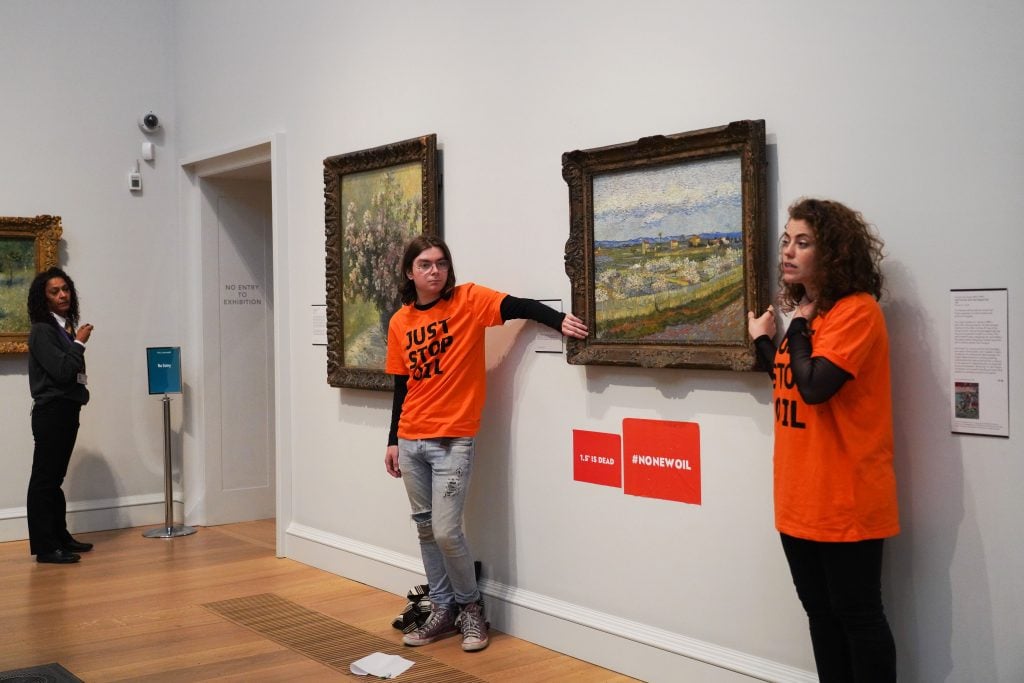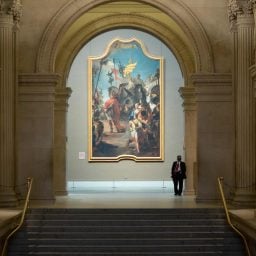Climate activists turned up the heat this year, decrying the global environmental crisis by targeting internationally renowned art museums’ greatest treasures—and leading many onlookers to wonder how their actions actually connect with the greater good. Just last week, protesters from Just Stop Oil glued themselves to Vermeer’s iconic Girl With a Pearl Earring in the latest of their ongoing art demonstrations, previously focused on the U.K.
The same group blasted a Rolex store in London with orange paint less than 24 hours later. In response to the mounting wave, France’s culture minister called on the country’s museums last week to “redouble their vigilance.” Guards at the Musée d’Orsay in Paris subsequently stopped a Just Stop Oil protestor from gluing and souping Van Gogh’s Self-portrait in Saint Remy this weekend, as soon as the protester removed her sweater to reveal Just Stop Oil’s signature white shirt beneath.
But Just Stop Oil isn’t acting in isolation. Their antics have been joined with demonstrations by Extinction Rebellion, Germany’s Letzte Generation, and Italy’s Ultima Generazione. (Although the last two groups’ names both mean “The Last Generation,” they’re apparently of no relation.) And some of these activists have received financial support from the likes of oil heiress Aileen Getty.
Gluing has proven, well, a reliable connection among these disparate activists’ public disruptions. Sometimes foods like tomato soup, mashed potatoes, and cake appear. Another common thread seems to be that activists are training their ire on historical rather than contemporary work. Just Stop Oil seems to favor pastoral paintings, while Ultima Generazione has targeted sculptures by Italian artists Botticelli and Boccioni.
Museum staff aren’t even the most outraged respondents. Normally, museum visitors verbally attack activists during their action. Louis McKechnie, one of two protestors who demonstrated on Van Gogh’s Peach Trees in Blossom, separately affixed himself to a soccer goalpost this year—and was assaulted by a sports fan. In July, Artnews spoke with Extinction Rebellion’s Simon Bramwell, who said employees at the Royal Academy understood their motives. Security guards joined them in singing, “There Ain’t No Mountain High Enough.”
After all, activists reason, what’s will the value of art be in the future if you can’t even eat?
Staging a spectacle before a famous artwork won’t reanimate wiped out animal species or force water levels to recede, but it might shake audiences free from our status quo. Some outlets liken these activists’ approach to The Situationists’ adage, “Sous les pavés, la plage!” (“Beneath the pavement, a beach”). Under entrenched rhythms lies the possibility for novel utopias.
Now that their collective modus operandi is becoming predictable, it’s also becoming its own kind of pavement. Here’s an ongoing list of climate protest art incidents from 2022 alone, before we all get too used to glue and force them to do something new.
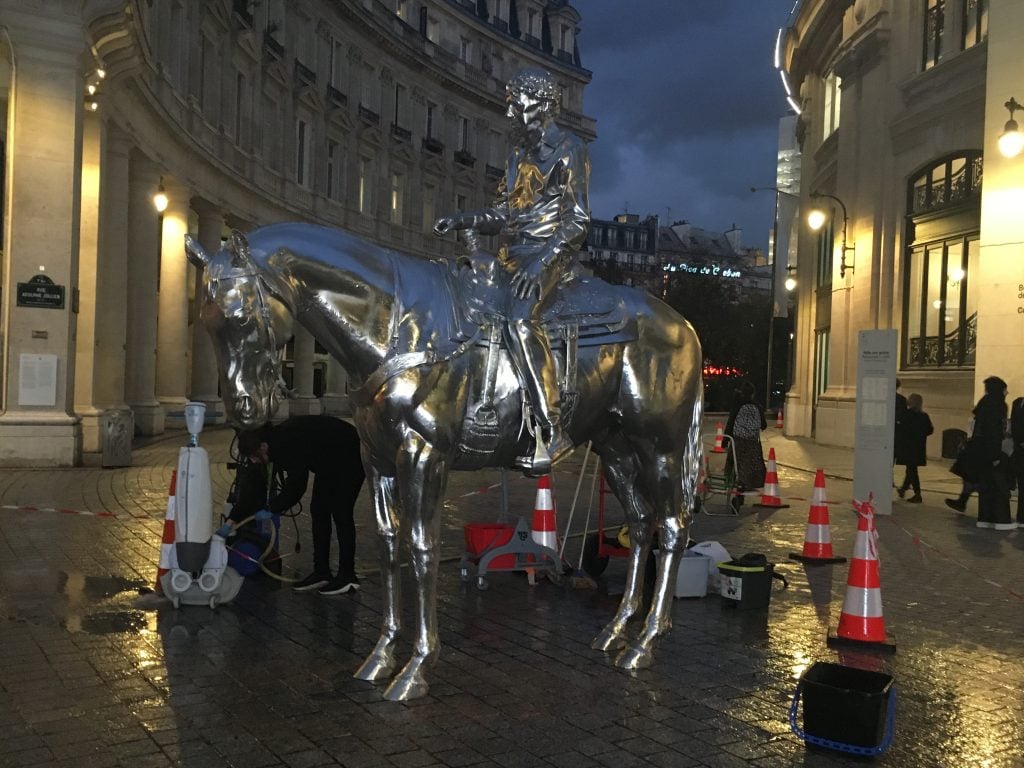
Charles Ray’s sculpture after a thorough cleaning on Friday, November 18. Photo: Anna Sansom.
Two young activists named Rachel and Aruanu took their mission beyond the institution’s walls, out into the street, dousing American sculptor Charles Ray’s Horse and Rider (2014) with orange paint. The work stands before the Bourse de Commerce – Pinault Collection in Paris. Then, the activists redressed the horse’s jockey in a white t-shirt reading “We have 858 days left.” Though French group Dernière Rénovation (Last Renewal) took responsibility on social media for their demonstration, both renegades have been tied to the larger A22Network, affiliated with Just Stop Oil. “Thank you to the restorers who intervened quickly,” French culture minister Rima Abdul-Malak responded on Twitter—the artwork was cleaned that same day. “Art and ecology are not mutually exclusive. On the contrary, they are common causes!”
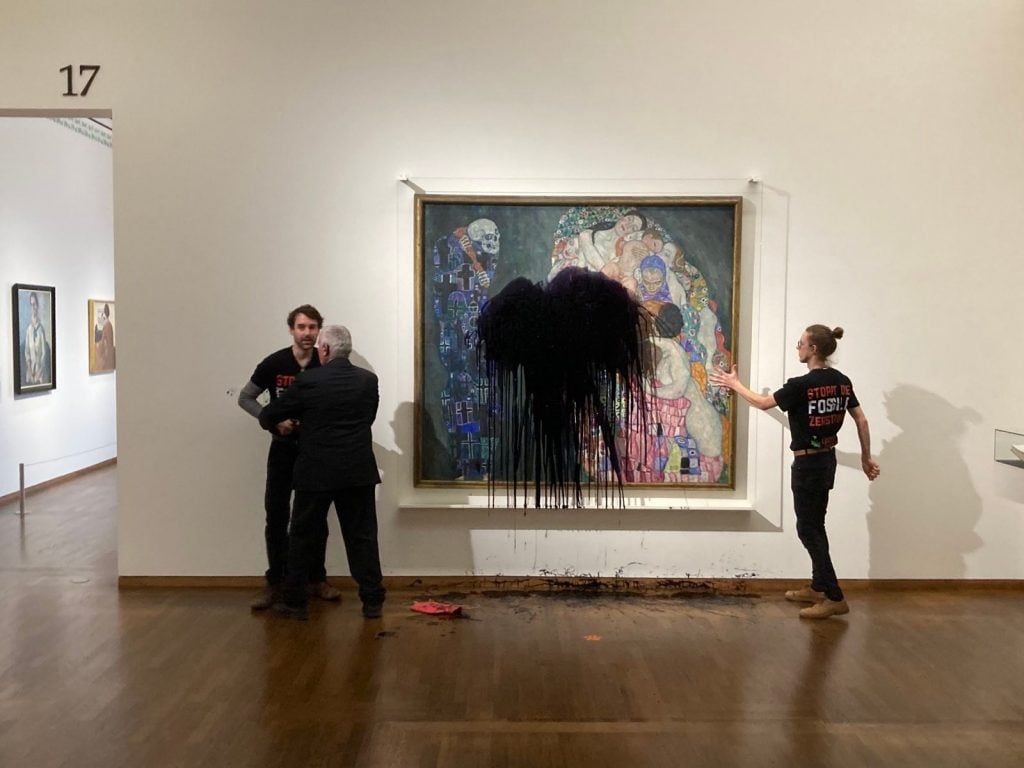
Two activists for Letzte Generation (Last Generation) throw “a black, oily liquid” at a painting by Klimt at the Leopold Museum in Vienna on November 15, 2022. Photo courtesy of Letzte Generation Österreich.
Two activists from German group Letzte Generation infiltrated the Leopold Museum in Vienna and sloshed “a black, oily liquid” at the protective glass, covering Klimt’s 1915 work Life and Death. One protestor managed to glue themselves to the glass, but a security guard pushed the second activist away before they could follow suit. “Stop the fossil fuel destruction,” one told the room. “We are racing towards a climate hell.” Since glass covers the frame, neither it nor the work were harmed. The glass itself, and the surrounding wall and floor, were not so lucky. Police took both people from the scene, which was quickly cleaned up, and Austria’s culture minister Andrea Mayer subsequently issued a statement, reminding audiences that “art and culture are allies in the fight against climate catastrophe.”
In Barcelona, Spanish group Futro Vegetal poured red and brown slime (to represent blood and oil) over a case containing a replica mummy at the Egyptian Museum. The action was intended to protest the COP27 global climate conference, taking place in Egypt at the time—particularly climate infringements by Coca Cola, the summit’s main sponsor. “While the UN foresees a rise of 2.5 degrees Celsius, our political leaders sit together for the 27th time, at a table paid for by Coca-Cola, an ecocidal corporation,” the group wrote on Twitter. The Egyptian Museum condemned the act on Twitter, writing, “Museum organizations are platforms for scientific dissemination, spaces for critical reflection and organizations dedicated to the protection of cultural and natural heritage, aligned and committed to the fight against climate change.”
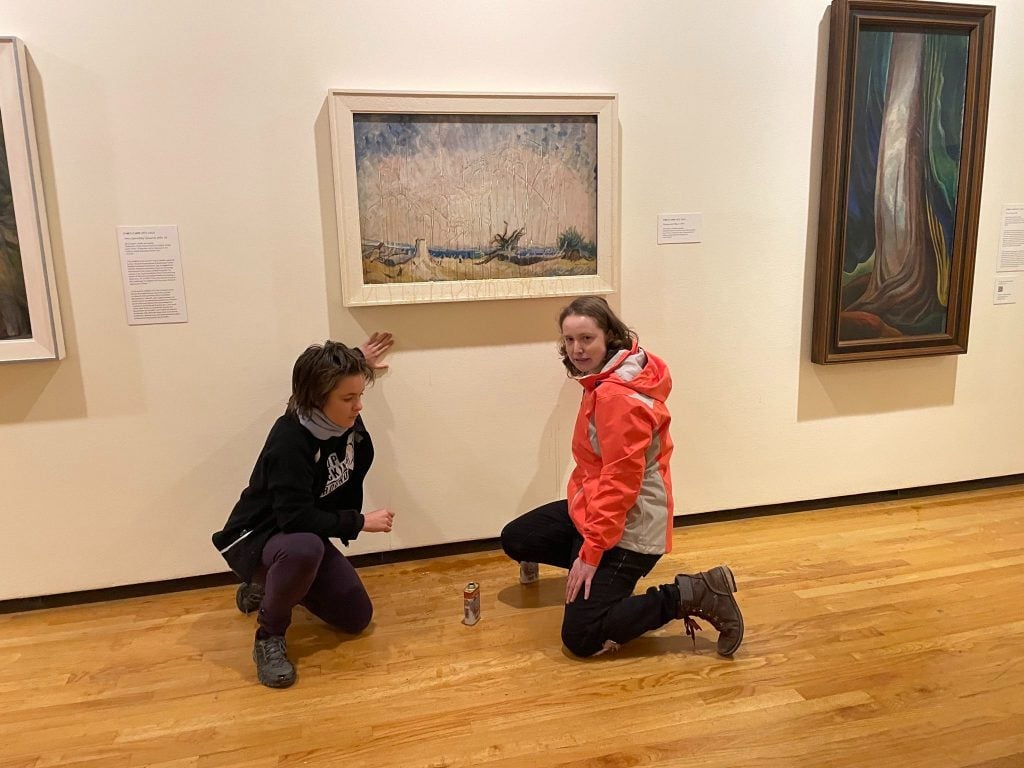
Two climate activists for Stop Fracking Around throw maple syrup at a painting by Emily Carr at Vancouver Art Gallery on Saturday November 12, 2022. Photo courtesy of Stop Fracking Around.
Three protestors from environmentalist group Stop Fracking Around brought this genre of climate activism across the Atlantic. Two members from the group threw maple syrup at a seaside Emily Carr landscape from 1934 at the Vancouver Art Gallery in Canada. Then, they glued themselves to the wall around it, while their third member filmed the demonstration. Stop Fracking Around is specifically aiming to halt construction on the Coastal GasLink pipeline in British Columbia, which also passes through several First Nations peoples’ traditional and unceded lands. “I think any amount of publicity we can get as an organization is worth it because the climate crisis is the most pressing crisis of our time,” one of the protestors, Emily Kelsall, told CBC News. Vancouver Art Gallery’s official statement on “the event of November 12” noted that no damage was done to the artwork. No arrests were made either, the Vancouver police said, though they were investigating the case.
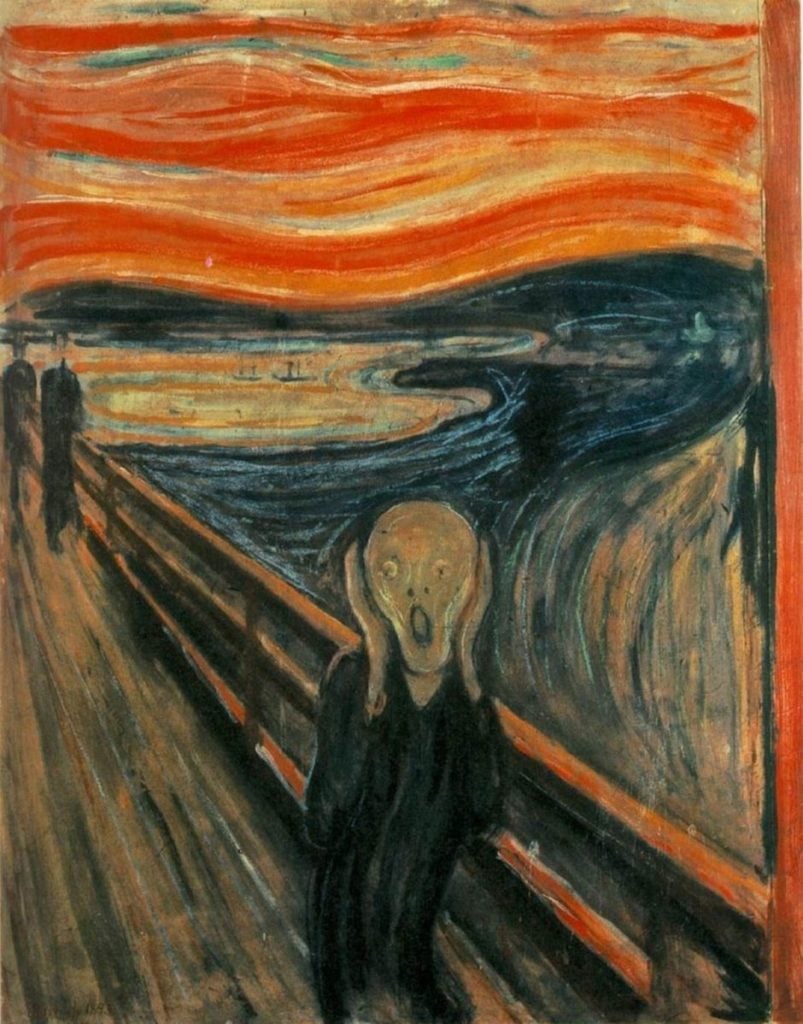
Edvard Munch, The Scream (1893). Courtesy of the National Gallery of Norway.
An international group of three protesters from Germany, Finland, and Denmark met at the National Gallery of Norway to try and stage a demonstration on behalf of Norwegian activist group “Stopp oljeletinga” (Stop Oil Exploration). Two women from the group started gluing themselves to the wall around Munch’s iconic painting The Scream, until a security guard identified what was happening and intervened. All three activists were taken into custody, including the third party filming it all. The room was emptied and closed to the public for a moment. The artwork and its accompanying protective glass were pronounced fine.
Just one day after Ultima Generazione attacked van Gogh’s work in Rome, two protestors from a lesser-known Spanish environmental activist group called Futuro Vegetal taped themselves to frames surrounding two Goya artworks: The Clothed Maja and The Naked Maja at Madrid’s world-famous Museo de Prado. They wrote “1.5 C” in big black letters on the expanse of wall between the two artworks. “Last week, the UN recognized the impossibility of… the Paris Agreement’s goal of staying below a 1.5 celsius degree change,” Futuro Vegetal wrote in a Twitter post, including footage of its Prado action. “We condemn the act of protest that has taken place in the museum,” the Prado responded in its own statement. “The works have not been damaged, though the frames are slightly damaged. We are working to get back to normal as soon as possible. We reject endangering cultural heritage as a means of protest.”

Protesters from the action group Ultima Generazione glue themselves to a wall after throwing soup on Vincent Van Gogh’s painting Sower at Sunset. Photo: Laura Lezza/Getty Images.
Three activists from Italy’s Ultima Generazione threw pea soup at Van Gogh’s The Sower (1888), on view at the Palazzo Bonaparte in Rome, where it’s on loan from the Netherlands’s Kröller-Müller Museum for a special exhibition on Impressionism. “We shouldn’t get angry about a painting that is protected by glass and will be clean tomorrow,” one protestor yelled during the demonstration. “And we don’t get angry because we don’t know that we are losing food and water.” The work was unharmed thanks to protective glass, and the four young people involved with the action were questioned by museum authorities. Right-wing Italian culture minister Gennaro Sangiuliano spoke out after the attack. “Attacking art is a vile act that must be resolutely condemned,” he said. “Culture, which is a key part of our identity, should be defended and protected and not used as a megaphone for other forms of protest.”
Two Letzte Generation protestors, Caris Connell and Solvig Schinkoethe, donned the group’s distinctive orange vests and glued themselves to surrounding handrails and supportive poles propping up an unidentified, four-legged dinosaur at Berlin’s Natural History Museum. Their free hands hoisted a matching orange banner that read, “What if the government can’t handle it?” in German. “Unlike the dinosaurs, we hold our fate in our own hands,” Connell told onlookers. “Do we want to go extinct like the dinosaurs, or do we want to survive?” According to New York Post, it was 20 minutes until authorities arrived, and 40 until they were unglued. Both protestors have been charged with criminal trespassing and property damage. The dino itself is safe.
The same day as the dinosaur display incident, an apparently independent protestor at Berlin’s Alte Nationalgalerie broke from food and glue to spatter Henri de Toulouse-Lautrec’s Clown with fake blood, in what some have called a copycat case. The maverick even super glued their hand to the wall. ABCNews reported the activist was handing out leaflets before the attack, the contents of which haven’t yet been specified. The perpetrator was scraped off and taken into custody, while the artwork entered assessment. Hermann Parzinger, head of the Prussian Cultural Heritage Foundation, which oversees the museum, said the art itself appears to be fine, but the wall needs repairs.
Two men in Just Stop Oil shirts approached Vermeer’s Girl With a Pearl Earring at the Mauritshuis museum in The Hague. One started gluing his shaved head to the work’s protected surface. “How do you feel when you see something beautiful and priceless apparently being destroyed before your eyes?” the other asked, after dumping tomato soup over his partner’s head. Onlookers chastised the pair, shouting “Shame on you” and more. “Where is that feeling when you see the planet being destroyed?” the vocal protester pressed. Both men were arrested and sentenced to a four-month jail term on November 2. Officials at the Hague have said the painting is safe, and they’re considering further safety measures.
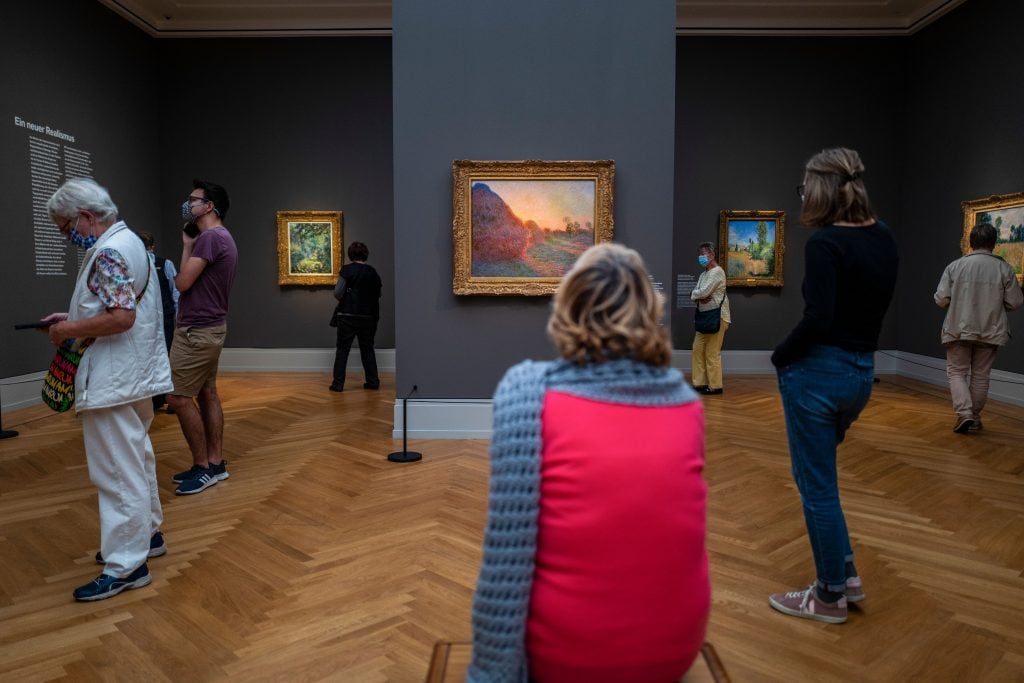
Monet’s Haystacks (1890) on display at the Barberini museum in Potsdam on September 24, 2020. Photo: John MaDougall/AFP via Getty Images)
Two Letzte Generation activists acted fast at the Barberini in Potsdam, Germany, each throwing their own buckets of yellow goo later identified as mashed potatoes on Monet’s Haystacks. The room fell silent as each glued a hand to the wall around the work and began a speech about the climate crisis. When protestor Mirjam Herrmann began talking, onlookers started expressing their disdain. She spoke over them as museum officials converged on the scene. Both protesters were taken to jail. The artwork was not damaged. The museum was closed for a week after.
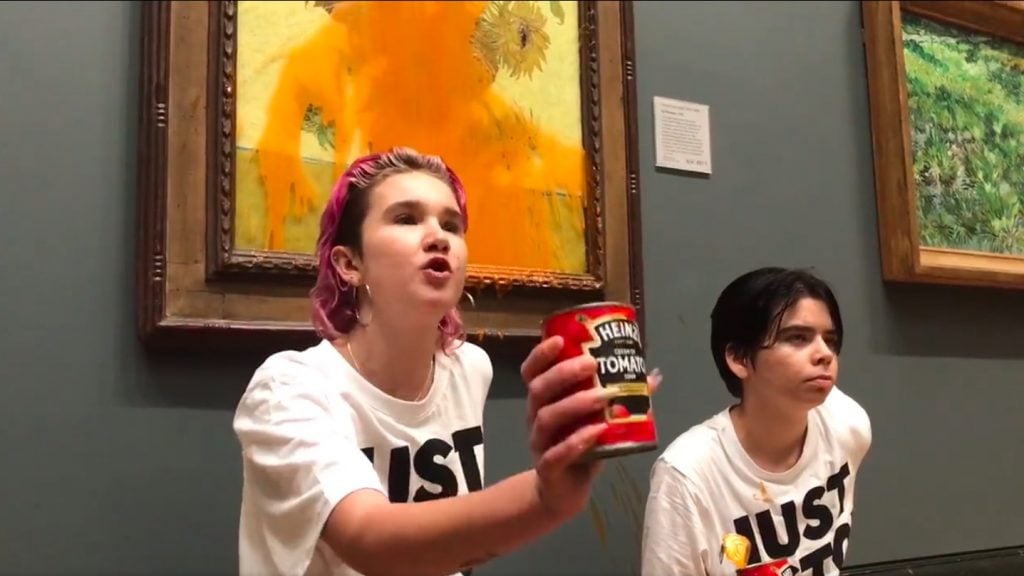
Phoebe Plummer and Anna Holland from Just Stop Oil addressing the public after throwing tomato soup on Vincent van Gogh’s Vase with Fifteen Sunflowers (1888). Screenshot by @damiengayle.
Two Just Stop Oil activists—Phoebe Plummer and Anna Holland—astounded attendees at London’s National Gallery when they threw cans of tomato soup on Vincent van Gogh’s Fifteen Sunflowers at close range. An audible gasp of “Oh my gosh” rang out immediately from onlookers. The duo then emptied tubes of glue on their hands and affixed them to the wall before starting their speech: “The cost of living crisis is part of the cost of oil crisis, fuel is unaffordable to millions of cold, hungry families,” Plummer said. “They can’t even afford to heat a tin of soup.” She and Holland were both arrested, and the artwork’s confirmed fine now—protected, like the others, by glass.
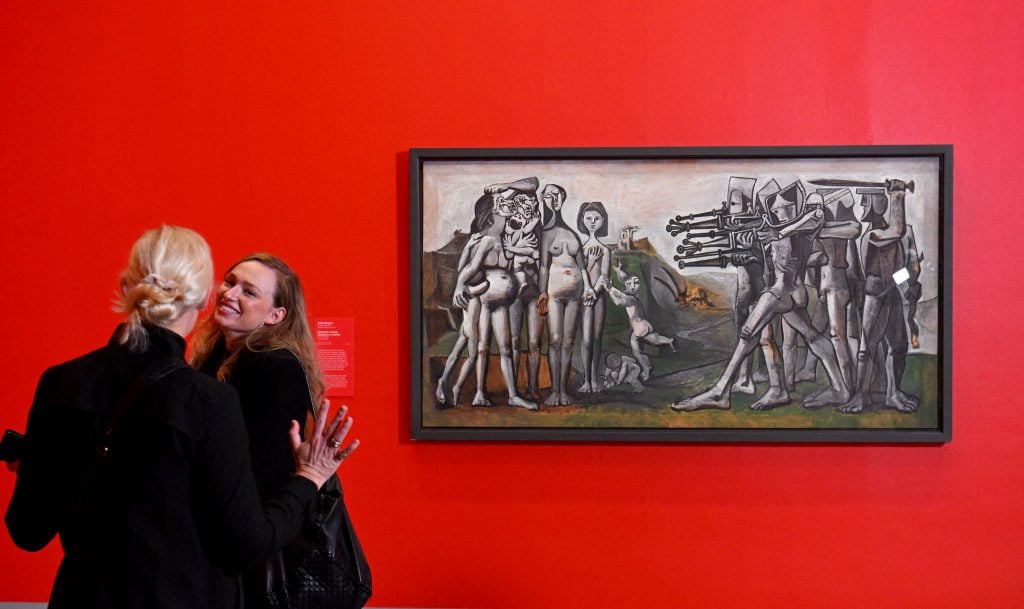
People stand next to Massacre in Korea by Pablo Picasso at an exhibition of more than 80 artworks by him at the National Gallery of Victoria in Melbourne on June 9, 2022. Photo: William West/AFP via Getty Images.
Two Australian activists from Extinction Rebellion stole the spotlight from Europe in all black outfits, gluing their hands to Picasso’s Massacre in Korea at the National Gallery of Victoria in Melbourne and unfolding a banner that read “CLIMATE CHAOS = WAR + FAMINE” on the floor. Perspex glazing protected the painting from damage. Some outlets wondered if this was the right work for their purposes, since it addresses the separate matter of American atrocities during the Korean War. Both protesters were arrested and later released.
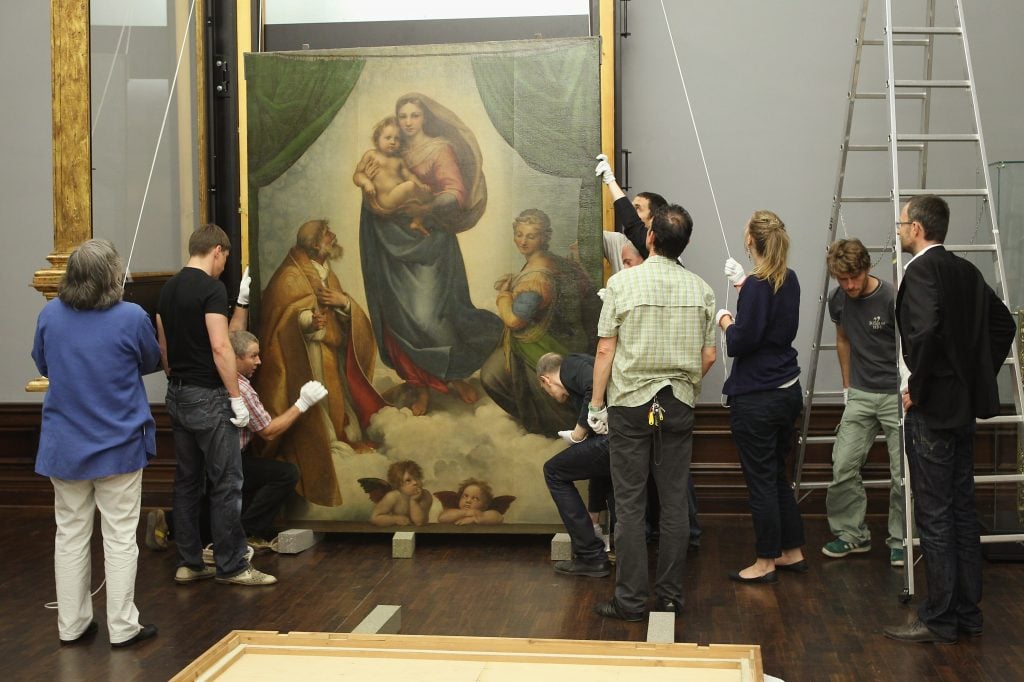
Gallery assistants guide the Sistine Madonna by Raphael into its new frame at the Galerie Alte Meister museum in Dresden, Germany, on May 23, 2012. Photo: Sean Gallup/Getty Images.
Jakob Beyer and Maike Gruns, both with Letzte Generation, skipped the foodstuffs and glued their hands to the ornate gold frame around Raphael’s Sistine Madonna at the Old Masters Picture Gallery in Dresden. The Daily Mail said they told security it was “an act of solidarity for Dresden-based activist Christian Bläul, 40, who glued his hands to a motorway in Stockholm.” They chose this work to emphasize similarities between Jesus and Mary’s fear of the future, and humanity’s fears at this pivotal moment. Both were taken to jail. The picture was unharmed, but the Dresden State Art Collections is suing both activists for damage to its frame.
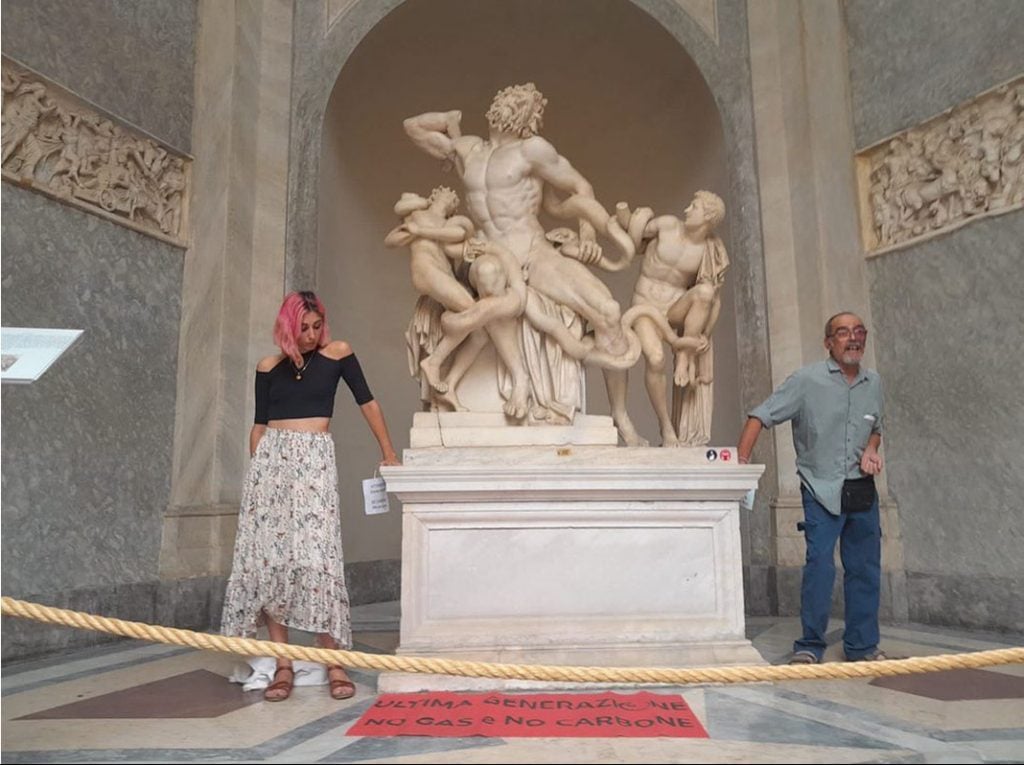
Ultima Generazione activists glued themselves to Laocoön and His Sons at the Vatican Museum in Rome. Photo: courtesy of Ultima Generazione.
One morning, two activists from Ultima Generazione glued their hands to the base of one of ancient Rome’s most famous sculptures and unfurled their group’s banner. “Like Laocoon, scientists and activists are the witnesses trying to warn those around them about the consequences today’s actions will have on the future,” a statement from the group said. “Like Laocoon, scientists and activists are not listened to.” Minutes later, security cleared the room and seized cell phones from Ultima Generazione activists in the audience.
Four activists from Ultima Generazione glued themselves to famed futurist sculpture Unique Forms of Continuity in Space at the Museo del Novecento in Milan, choosing this work to highlight society’s need for a new direction. They targeted its plinth specifically to ensure the sculpture’s safety, and even “consulted restorers who advised them to use a suitable adhesive.” Law enforcement took them into custody, and the museum closed after. The work itself remains, in fact, undamaged.
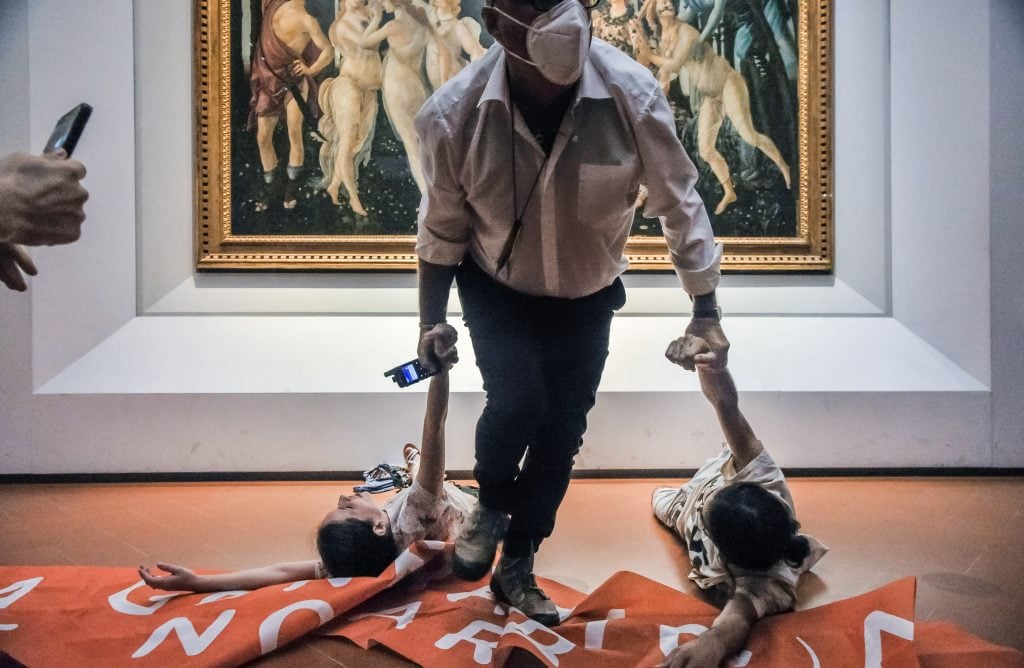
Protesters from the action group Ultima Generazione being dragged out of the Uffizi in Florence, Italy, after gluing their hands to the glass covering Sandro Botticelli’s Primavera. Photo: Laura Lezza/Getty Images.
Ultima Generazione sparked their first major art uproar when two protestors (a man and woman who each paid for admission to the Uffizi in Florence) glued their palms to the glass protecting Botticelli’s Primavera and displayed their signature banner. “Is it possible to see a spring as beautiful as this today?” Ultima Generazione asked in a subsequent statement. Both protestors were taken into custody, and the painting got through unscathed.
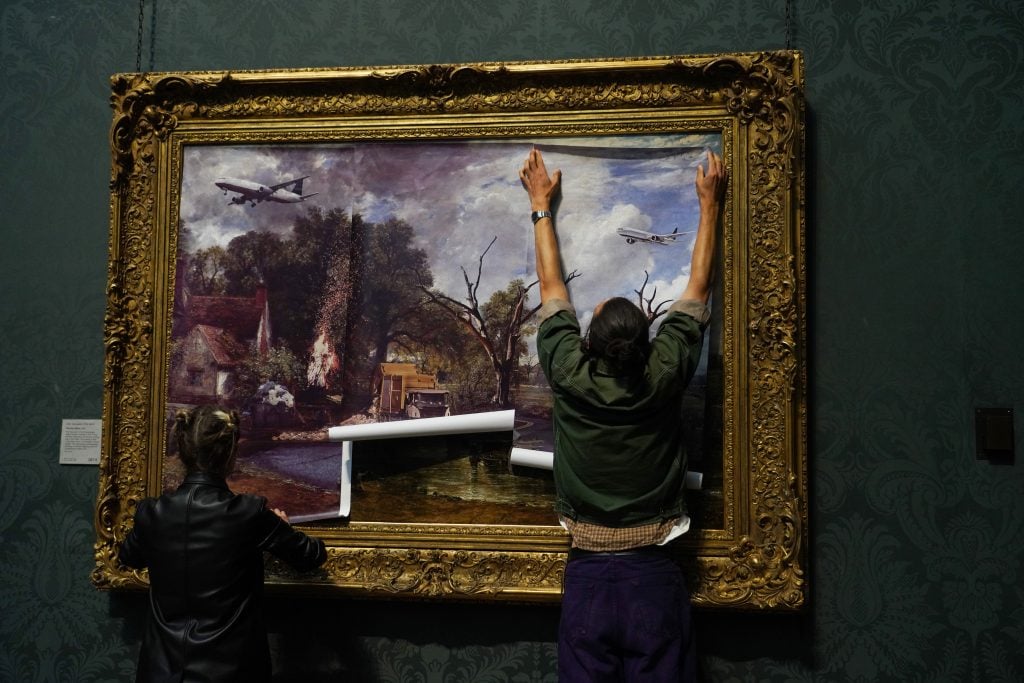
Just Stop Oil climate activists Hannah Hunt and Eben Lazarus glue themselves to the frame of The Hay Wain by John Constable at the National Gallery in London, on July 4, 2022. Photo: Kristian Buus/In Pictures via Getty Images.
Just Stop Oil embarked on a rapid-fire campaign across the U.K. at the start of summer, targeting four historic paintings at four different galleries: Van Gogh’s Peach Trees in Blossom at the Courtauld Gallery in London, John Constable’s The Hay Wain at London’s National Gallery, Horatio McCulloch’s My Heart’s in the Highland at Glasgow’s Kelvingrove Museum, and J.M.W. Turner’s Tomson’s Aeolian Harp at the Manchester Art Gallery. In each case, protestors glued themselves to the work in question, but The Hay Wain got special treatment, covered with an updated scene in a state of climate apocalypse.
One absurd omen predated all these shenanigans. Several million news cycles ago, a man dressed as an elderly woman leapt from a decoy wheelchair—first, to bang on the work’s high-tech glass covering and then to assault art history’s most famous lady with cake. Fortunately, protective measures installed in 2019, following previous incidents, kept her safe. “There are people who are destroying the Earth,” the perpetrator said. “All artists, think about the Earth. That’s why I did this. Think of the planet.”
